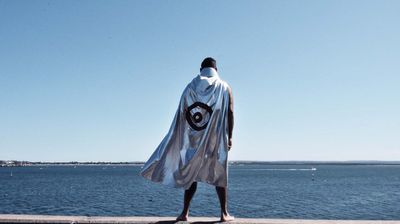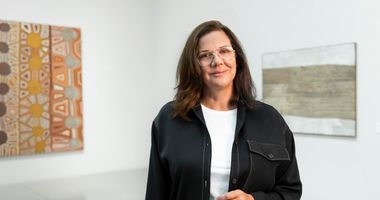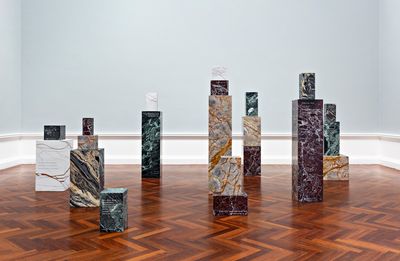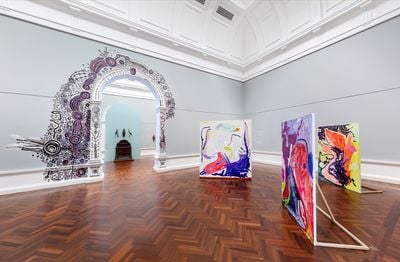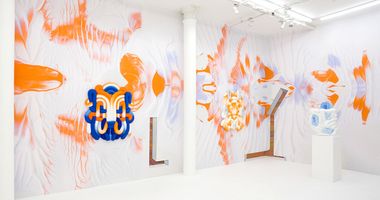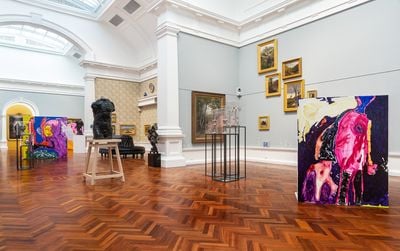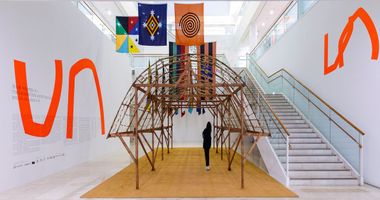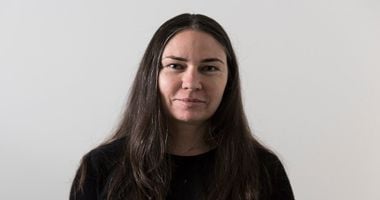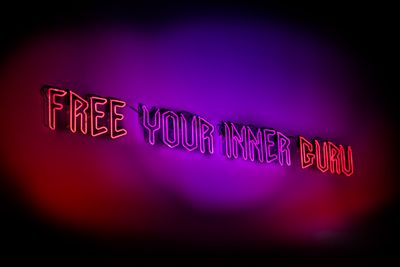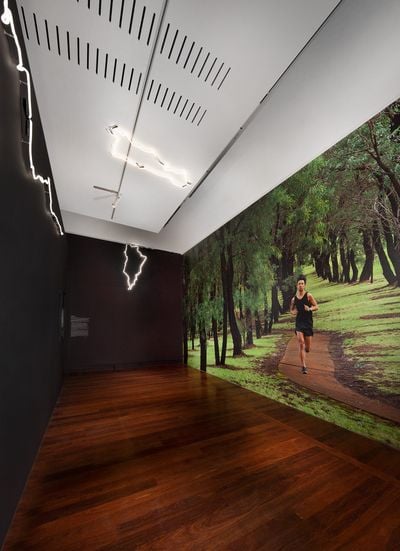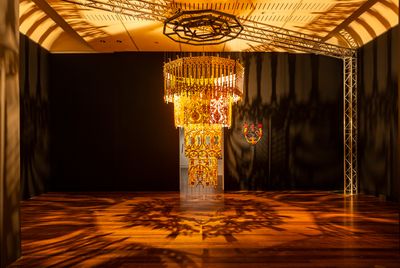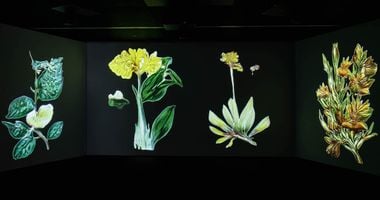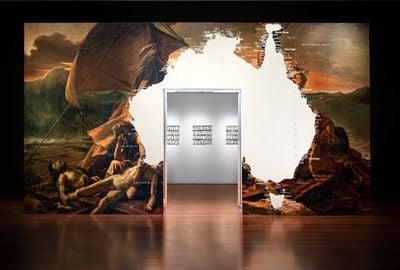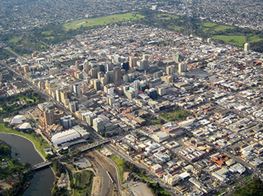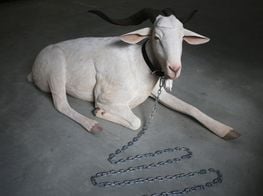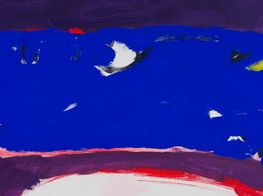Adelaide Biennial Challenges the Myth of the Free State
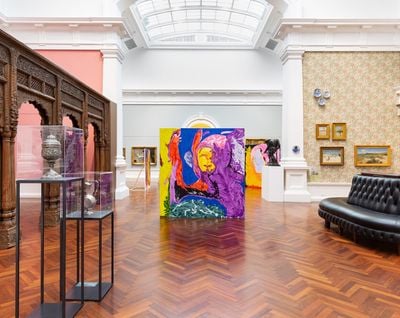
Exhibition view: 2022 Adelaide Biennial of Australian Art: Free/State, Art Gallery of South Australia, Adelaide (4 March–5 June 2022). Courtesy Art Gallery of South Australia. Photo: Saul Steed.
Australia's only colony to have been established without convict settlers, South Australia may be perceived as the country's only free state. But can any state in a colony be free? The 2022 Adelaide Biennial of Australian Art considers the question.
In contrast to its expansive 2020 edition, the 2022 Adelaide Biennial takes place in one building, the Art Gallery of South Australia (AGSA), and leads with the ambiguous title: Free/State.
Curator and Burramattagal descendant Sebastian Goldspink's chosen title may seem like a strange choice. First Nations peoples in Australia like myself and Goldspink, whose land has been colonised, have never been free, and it's a point that this show contends with.
Free/State is a labyrinth—it takes more than a day to see it in its entirety, even for viewers who are familiar with the art and artists included. Beginning at the entrance with Kate Scardifield's monumental hanging banners of blue and orange fabric (ALARUM, 2022), the exhibition is spread across AGSA's Elder Wing and two floors of the gallery's west wing.
The Wine Dark Sea (2021) by Stanislava Pinchuk, one of the first works viewers encounter in the Elder Wing, is timely and topical; perhaps one of the most significant in the entire show. The assemblage of columns is constructed from marble blocks whose surfaces are engraved and gilded with words combining text from Homer's Odyssey (c. 8th century) with leaked communications by refugees detained under Australia's indefinite detention system.
The Wine Dark Sea speaks to the horror of being rendered stateless, the racism in Australia's refugee detention, and of our shared humanity, while questioning any conception of freedom that includes locking people up for seeking refuge.
This was driven home with incredible poignancy during the press preview for the show when the curator cried as he spoke of Pinchuk's homeland, Ukraine, which was being torn apart as we stood at the gallery talking about art, her people escaping as refugees. Sometimes art cuts too deep.
Acting like a gateway to the rest of the show is a traditional Aboriginal painting of Country by Pitjantjatjara artist Rhoda Tjitayi, which has been applied directly on the wall surrounding an arch of Gallery 1 in the Elder Wing. Titled Piltati Tjukurpa (2022), acrylic lines, whirls, and dots in shades of black and dark purple contrast with the pale, mint-blue wall and white arch of the historic building.
Positioned across the Elder Wing and woven into the institution's permanent collection are free-standing framed canvases by Tom Polo, interrupting and interrogating the space of the building.
Each of Polo's paintings stands upright, braced with pine planks, their triangular framing visible from behind. These abstract, impressionistic works, with high-contrasting colours almost to the point of gaudiness, and active, almost forceful strokes, are spectacular in how they assert themselves in the space.
As a whole, Free/State reflects the complex history of South Australia, whose self-identity as the continent's only free state is challenged by the placement of works amid collections that track the very historical narrative that the Adelaide Biennial seeks to upend.
In this dense overlapping of histories is a stark reminder: the land on which this show unfolds—and the lands beyond it on which settler states have been established—is far from free.
But while the gallery's collection, like many in Australia, contains colonial and European art that reflects Australia's history as a colony of European power, it also houses, alongside the neighbouring South Australian Museum, huge collections of Indigenous arts and material culture.
The evolution of these collections speaks to what curator Sebastian Goldspink writes in the 2022 Adelaide Biennial catalogue, describing the show as 'a reflection of a contemporary multicultural Australia still grappling with its past and defining its future.'
As if marking that trail, Polo's paintings lead visitors onwards, like a series of directions or prompts towards the primary exhibition galleries at the top and bottom floors of the gallery's west wing, where works by First Nations artists vigorously interrogate the Free/State theme.
Walking downstairs to the lower ground floor, Reko Rennie's powerful, hypnotic, and muscular three-channel projection comes into view, as it unfolds across the longest unbroken wall in the building. Two video works play one after the other on eternal loop on the same screen: OA_RR (2016) and the newer Initiation OA_RR (2021).
In the first, the artist does burnouts in a 1973 Rolls-Royce Corniche in the red dirt of his ancestral country, creating a series of ephemeral traces in the dust that reference Kamilaroi ceremonial engravings. Despite its appearance, the work is tender, speaking of love and family, and was heartbreakingly inspired by Rennie's grandmother's removal from Country to be enslaved and never return.
The second sees the artist cruising the streets of Melbourne's western suburbs, where he came of age, in a hot pink Holden Monaro. Here also, Rennie enacts a series of burnouts, bringing Kamilaroi engraving motifs into the urban context.
The exhibition continues through a series of doorways and rooms, with temporary and existing walls creating a labyrinth, using spaces to great effect to bring together stories by First Nations and non-Indigenous artists.
Arranged in one room is a cluster of perfectly crafted pieces of wooden furniture by James Tylor and Rebecca Selleck, all from 2022—a table with benches, cabinets, and bronze sculptures of bush tucker, the traditional foods Indigenous communities lived on before colonisation, showing Aboriginal people were here first.
Nearby, Abdul-Rahman Abdullah's rendition of a walk-in fridge, In the name (2015–2022), contains hanging silicon casts of lamb carcasses, telling the story of the artist's home and cultural upbringing as a Muslim Australian man.
At the other end of the gallery is a crowd of sinuous Warraburnburn (2021) figures, spirit beings carved of wood and painted in black and white, some small, others taller than an adult man, by Murrungun artist Serena Bonson.
Further down, Kamilaroi artist Dennis Golding's room-filling installation Casting shadows (Chandelier) (2022) is formed of resin panels cast from iron lacework from Victorian terraced houses in 'The Block'—a community established by Aboriginal activists in Sydney that was bulldozed in 2011. The shadows of the work, cast from a light hanging inside the structure, extend beyond the work itself, onto the walls of the room where it hangs alone, filling the space with memory.
To extend, expand, and decentre colonial histories is never a simple or straightforward task, given the intersecting trajectories and lives that define settler colonialism.
Take Dean Cross' gunalgunal (contracted field) (2021–2022), which cuts through a reproduction of Théodore Géricault's painting The Raft of the Medusa (1818–1819), depicting the French frigate vessel used in the slave trade in Senegal, here overlaid by a white-washed map of Australia.
The overall structure is gargantuan. The framing of wood and wire, reminiscent of a film prop, is clearly visible in the void inside the structure, while the opposite side of the painting depicts a pattern in bent, steel star pickets—items used to divide and colonise the land.
In this dense overlapping of histories is a stark reminder: the land on which this show unfolds—and the lands beyond it on which settler states have been established—is far from free. —[O]

